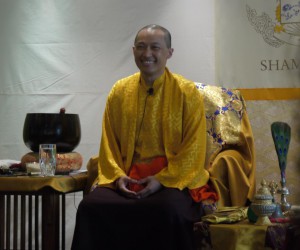Saturday
Featured StoriesA Technology of Heart
Creating Enlightened Society through Imagining Peacewith Sakyong Mipham Rinpoche
at Rockefeller Chapel, University of Chicago
April 26, 2013
by Debra Hiers, Shambhala Times Reporter
Entering Rockefeller Chapel tonight there was a high-energy buzz amongst those gathering, sangha friends and acquaintances greeting each other, finding seats. We were there for one reason: to hear what the Sakyong has to say about creating enlightened society. We all, in theory, want to do this, but what exactly is enlightened society, and how do we get there in this mess of a world?
The Fulcrum Point New Music Project brought a brass chamber ensemble to the stage to begin the evening. As their music resonated in the spaciousness of the chapel, the near capacity crowd grew quiet and attentive, and a restful joyous peace took hold. It reminded me of the role art plays in lifting the spirit, opening the heart, and summoning wakefulness.
Elizabeth Davenport, Dean of Rockefeller Chapel, introduced President Richard Reoch of Shambhala International, who in turn introduced Sakyong Mipham Rinpoche. For those in the audience who were new to the Shambhala lineage of Tibetan Buddhism, President Reoch talked about the meaning of the Sakyong’s name, how Sakyong means earth protector, Mipham was one of Tibet’s most revered teachers and is given to the Sakyong in accordance with the rebirth of that wisdom teacher. Lastly, he shared that Rinpoche means precious one.
There have been important periods in Rinpoche’s life when he has been on retreat in India, immersed in his own practice and study. Each time he has been away on one of these long retreats has proven to be a turning point in furthering the teachings and practices offered to the Shambhala community. These Enlightened Society Gatherings occurring over the next few months represent another important turning point. Along with the many technological advancements of our time we are in deep need of what the Sakyong referred to as a technology of heart to go along with it.
Rinpoche’s new book, The Shambhala Prinicple, details his life from the perspective of what he learned from his father, Chogyam Trungpa Rinpoche, about the principles of basic goodness and establishing enlightened society.
Trungpa Rinpoche played a large role in bringing Buddhism to the West and establishing a strong network of meditation centers. Perhaps the most influential and radical foundation of Trungpa’s Shambhala teachings is that humanity is basically good and that we are inherently worthy. It is not just simplistic, new agey fluff. Rinpoche said that this teaching did not come out of a “naïve culture.” His father essentially lost his country, his homeland, and yet he chose to go on, to carry the Shambhala teachings of basic goodness to the world.
“These days we get up and we’re overwhelmed,” said the Sakyong. But we have to ask ourselves if we are just trying to get through the day, and if we are, is that what we want to settle for?
By engaging in daily meditation practice, developing a strong body-mind connection we can change that. What the Sakyong is telling us is that if we change the way we approach our own lives, it will have a positive impact on society. Furthermore, he talked about the concept of “original peace.” Can we approach peace from the qualities of basic goodness inherent in human nature?Clearly, Rinpoche is calling for a paradigm shift in the way we practice, and the ways that we communicate our practice to the world. Even though the world is a messy place and there is so much violence, the Sakyong said, by developing inner strength we can be more “accommodating to these external forces. We have to learn more ways to communicate this,” Rinpoche continued. “Humanity has survived so far under incredible odds, and somehow we have flourished. What we are doing is making the impossible possible.”
As a young boy, he remembers asking his father which text he should read next. His father told him instead to, “Host a dinner and learn how to have a good conversation.” It’s a great way to cultivate patience, generosity, altruism, and love.
The Sakyong reminded us that we have this incredible opportunity to, as he put it, “Look at what the course of the future is going to be.” We can move it in the direction of basic goodness and creating enlightened society or we can let the status quo stand. “All questions come down to some sort of theory of life,” he continued. “It is good for society and all of us to think about these things. … At least by meditating, we’re not making things worse. … We need to fortify and support each other so we don’t give up.”
As we were leaving the event, the one word that seemed to pop up the most in conversation was “inspiring.” It was an inspired evening, and with that, the Sakyong has set the table for Saturday’s Imagining Peace conference.
Shambhala Times is delighted to share these “live reports” from the Imagining Peace weekend. Stay tuned for more articles brought to you by the hard work of a team of live reporters, including Debra Hiers, Claudine Mininni, Gretchen Neve, and Aarti Tejuja, and with the support of David Schreier.
~~
Debra Hiers is a freelance writer, poet, and musician living in Atlanta, GA. She has been a member of Shambhala since 1997.







Apr 29, 2013
Reply
Debra,
Thanks for the write-up. I want to find that intersection of developing my own deeper practice of meditation and the world-wide implications of approaching life from a belief in everyone’s basic goodness.